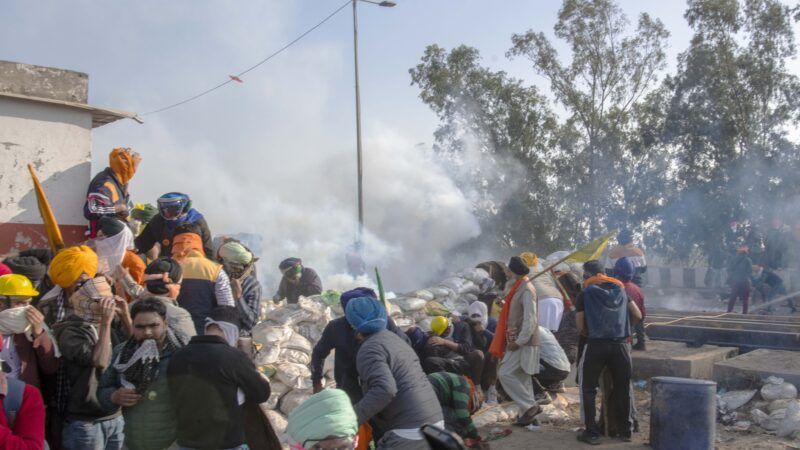The Government Can't Save India's Suffering Farmers
Protests in the country come from an understandable place. But their demands are divorced from certain unfortunate economic realities.

Thousands of Indian farmers continue to protest and demand legislation that would guarantee minimum crop prices for their yields, reinvigorating a 2020 debate that led the country to repeal several agricultural laws that farmers unions claimed were hostile to their livelihoods.
Core to the protesters' long list of demands is the push to enshrine into law a minimum support price (MSP), a staple of Indian economics where the federal government recommends price floors in an attempt to safeguard profit. It is currently advisory, not binding. The protesters—which the government has sought to stymie with displays of force, restrictions on the right to assembly, and online censorship—are also urging legislators to extend the MSP to all crops, not just the ones deemed essential.
But while it's true that farmers in India are legitimately struggling, their demands are divorced from certain unfortunate economic realities.
From August 2020 to December 2021, the Indian central government faced off against a coalition of farmers unions—mostly from the state of Punjab—over three contentious farm bills, drawn up with the goal of agricultural market reform and modernization. The bills would have broadly advanced steps to reduce government intervention in India's agricultural industry, which, as of 2022, makes up 43 percent of Indian labor. In essence, the farm bills aimed to make it easier for customers and contractors to directly purchase from producers, rather than through a public mechanism.
Many farmers feared those bills would get rid of the MSP and that the modernization of agriculture would empower corporations to control their livelihoods. Hundreds of thousands of farmers participated in demonstrations that involved sit-ins, traffic obstruction, and even suicides. Amid sustained pressure, the bills were ultimately repealed.
Narendra Modi, the prime minister of India, stood by the bills but apologized for failing to convince farmers of their utility. "Whatever I did was for farmers," Modi said in a statement. "What I am doing is for the country."
But as the debate over market reform ramps up again, an important point is flying under the radar: Despite employing nearly half of the country's work force, the agricultural industry in India—the world's fastest-growing G20 economy—has consistently contributed less than 20 percent of the nation's gross domestic product (GDP) since 2002. Though India's economy has expanded rapidly, many farmers have resisted changing occupations, and some have struggled to afford educational opportunities—leaving the profession oversaturated and other job markets undersaturated.
It gets worse: Though its agricultural industry is bloated with labor, India ranked 111th in the 2023 Global Hunger Index. The Public Distribution System in the country, which primarily supports the MSP, has been unable to efficiently distribute food and is riddled with corruption, undermining the very reason it exists.
Many farmers in India produce low yields due to circumstances mostly beyond their control: unreliable weather, a lack of diversity in crops, poor infrastructure, growing farmer debts, and antiquated agriculture practices. To put it plainly, Indian farmers rely on government aid because agriculture is simply not a sustainable market in the country. Enshrining the MSP into law would officially subsidize a struggling, overfilled sector with no end in sight.
Farmers' other demands include axing a 2020 bill that made room for private investment in electricity to withdrawing from free market agreements with the World Trade Organization. It is increasingly clear that the farmers' demands, while stemming from a place of real suffering, are fundamentally opposed to any semblance of a free market.
That's no secret. The New York Times explicitly referred to MSP as "social insurance," while a BBC article said the farm bills would relax laws that "have protected farmers from the free market for decades."
In February, the government offered a five-year plan to guarantee income for certain crops through the MSP, but it wasn't enough. The farmers declined. "After the discussion of both forums, it has been decided that if you analyze, there is nothing in the government's proposal," said Jagjit Singh Dallewal, one of the major protest leaders. "This is not in the favor of farmers."
But contra Dallewal, it is highly questionable that the MSP, which was introduced in the 1960s to address food shortages, is helping farmers consequentially. "MSP as currently implemented may not play a significant role in reducing agricultural commodity price market volatility," according to an analysis by researchers at the University of Illinois at Urbana-Champaign. "If MSP does not significantly decrease price volatility, then the benefits of the MSP program for farmers are unclear."
There is little to gain and much to lose when considering the government buying crops at fixed rates cannot possibly provide farmers a long-term solution to their very concrete poverty. Those much-maligned, erstwhile farm bills would have taken conservative steps toward liberalizing India's agricultural economy. Enacting the MSP as law, on the other hand, would be a massive step back for one of the world's major economies on the rise.


Show Comments (30)